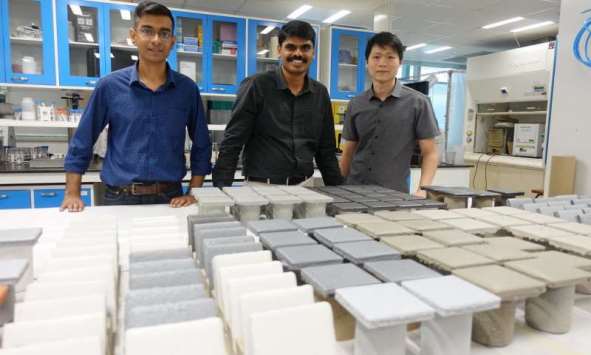Scientists from Nanyang Technological University, Singapore (NTU Singapore) and national industrial developer JTC Corp. (Singapore) developed a polyurethane-based nanocomposite coating system for fire and corrosion protection on reinforced concrete structures that is faster to apply and less expensive due to reduced materials and application requirements.
Work on the new FiroShield coating originated when the researchers were looking for a commercially viable solution to protect steel-reinforced concrete against underground fires. According to the researchers, their knowledge from years of research on different aspects of polymers and combustion—combined with civil and structural engineering experience—helped streamline their approach.
“In a fire, our coating forms a compact charred layer that acts as a protective barrier against the heat,” says Aravind Dasari, an NTU assistant professor. “While typical fire coatings will also form a charred layer, those are thick and foam-like, which can fall off easily and leave the steel exposed to the fire.”
“What we aimed at was an innovative coat that works differently from conventional intumescent coatings and can stick to the steel surface for as long as possible under high temperatures, and yet has durability and weather resistance under normal conditions without a need for a top coat,” he adds.
The strength of their coating comes from a balanced mix of additives, whose simultaneous chemical reactions work together when exposed to extremely high temperatures. The researchers say they knew that they had found the right formula when they were able to coat steel samples evenly with a spray gun.
Limitations of Traditional Methods
According to the scientists, reinforced concrete structures are usually coated with a fire-retardant layer to shield any bare metal from damage and to meet a fire protection standard of two hours—the standard in Singapore. That rule is designed to give occupants enough time to evacuate the building.
Traditional coating methods include intumescent paint and fire-resistant outer claddings, Dasari says, adding that intumescent paint is used in about 70% of antifire materials worldwide. The additional fire-retardant layer, however, makes for a thick overall coating and more stringent application requirements.
On the other hand, the researchers say their new coating can be applied on bare steel without the need for sandblasting to prepare the surface. The coating, which can be applied both indoors and outdoors, still protects against fire for two hours without falling off.
“The ease of application of this new fire and corrosion resistant coating on steel structures will help reduce labor-intensive work, thus improving productivity and enabling faster coating of prefabricated steel components,” says Koh Chwee, director of JTC's technical services division.
“More importantly, the new coating’s ability to maintain superior adhesion under high temperatures leads to increased building safety for occupants,” Chwee adds. “We are confident that the new coating will be able to reduce both paint material and labor costs.”
Although the combustion behavior of the new coating is different from classical intumescence, their actions are based on a similar condensed-phase mechanism, which creates a steep temperature gradient between the coating surface and the coating-concrete interface. Applying the coating on existing concrete structures can improve their fire performance without adding excessive weight, and the effects of fire-induced spalling can be alleviated, Dasari says.
Chemical Reaction Adheres Coating to Steel
While developers are not yet releasing their proprietary formula, they say the base material of the coating is made of synthetic resins.
To give it fire and corrosion-resistant properties, Dasari's team added a number of common chemicals, including one that is endothermic. This chemical absorbs heat to start a chemical reaction, thus causing the coating to adhere firmly to the substrate.
Pigments can then be added to the mixture, enabling the product to achieve the aesthetic function of normal paint. The coating can be applied to structural materials including steel, timber, and concrete.

To achieve a two-hour fire rating, the developers say the coating requires just five layers in total—as compared to 15 layers or more with many conventional coatings. As a result, they say it is two times faster to apply with a cost that is ~50% lower due to reduced materials cost and manpower requirements.
In testing the coating, the developers say its corrosion protection dipped by only 2% in the lab when exposed to weathering elements such as moisture and ultraviolet (UV) rays. As such, they believe the new coating can also reduce the maintenance cost and frequency of inspections over a building’s lifespan.
The coating was also tested on other construction materials, such as laminated timber, and showed similarly strong performance, according to the researchers.
Steps to Commercialization
For the next phase of the product's development, the coating will be sent to the United Kingdom for an industry certification. This certification process includes a load-bearing fire test. Currently, facilities in Singapore are not capable of conducting this test, the researchers explain.
After the certification, which is expected to be completed by April 2018, the coating will be applied to steel structures within JTC's new logistics hub building.
From there, the joint research team plans to work together to explore commercialization options and potential partners to roll out the technology on a larger scale.
Source: NTU Singapore, www.ntu.edu.sg. Contact Aravind Dasari, NTU Singapore—email: aravind@ntu.edu.sg.
References
1 “NTU and JTC Develop New Coating That Keeps Its Cool When the Heat Is On,” News Releases, Oct. 31, 2017, http://media.ntu.edu.sg/NewsReleases/Pages/newsdetail.aspx?news=af5b34e0-be0d-4cba-9124-3725457e8fed (Nov. 14, 2017).